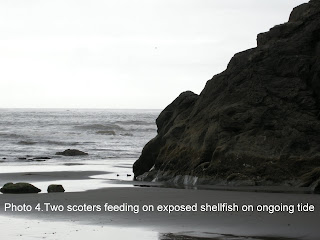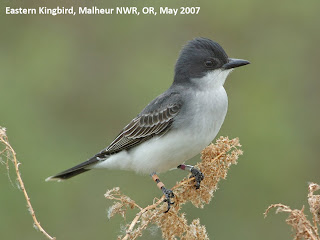At Potholes Reservoir, Grant Co, Washington I discovered a rather dramatic scene of thousands of bullfrog tadpoles that were trapped in drying mud holes on 29 Aug 2009 (Photo 1). The small mud hole at the top right was about 3 ft and the larger in the middle of the picture about 12 ft in diameter. The larger contained approx 5,000 bullfrog tadpoles based on counts of a few subsamples; most were dead. The two mud holes in the photo had water about 4” deep a week prior to the photo and the surface quivered with wriggling tadpoles when approached.
Typically bullfrog tadpoles in the Northwest remain in ponds for at least one winter and grow to a total length of about 130 mm+ before morphing into froglets. Most of the tadpoles had small to medium size hind legs and were less than 110 mm in total length, which is the lower extreme of the size when bullfrog tadpoles could morph (Photo 2). Under normal conditions with plenty of food and no crowding, the tadpoles in the picture would be about one year old, but if food limited or crowded, they could be two years old. Although most were not ready to morph, a few had started the process and were hopping away from the drying mud holes. The closest pond was 100 ft away, but with the heat and predators, their chances were not good (Photo 3 and 4). The mud recorded tracks of great blue herons, great egrets, killdeer or yellowlegs, coyotes and black-billed magpies (Photo 5). Yellowlegs have small mouths, but eat the tadpoles by vigorous shaking the tadpoles to pieces.
The dead and dying tadpoles illustrate one limit to this invasive species’ success – they can’t survive in ephemeral ponds. Although the area is flooded as the level of the reservoir rises during winter and spring, as the water level drops through the summer, they move to deeper water. The mud holes were at a low spot so presumably the tadpoles moved to the deeper water as the water level dropped through the summer, but they moved to the wrong pond and were cut off.
Bullfrogs have recently expanded into the main reservoir and are now extremely common in Crab Creek beaver ponds and in ponds near Job Corp Dike, which is at the NW corner of the reservoir. There were none in 2002, but tadpoles starting showing up in traps in 2006, and 2009 was the first year I observed adult and juveniles widespread throughout the region. One 12 m dia pond at the Job Corps Dike had over 100 frog heads visible as they floated on the surface waiting for a prey object to venture near (Photo 6). There were none at Dodson Road/Winchester Wasteway (10 mi to the west) or at I-road/Frenchman Hills Wasteway (16 mi WSW). They were recorded in lower Crab Creek, south of O’Sullivan Dam, prior to 2005 (WA Gap analysis). The species was introduced into Washington from east North American in the 1920-30’s for food, sport and for pond features and have since spread throughout lower Puget Sound and the Columbia basin and are slowly spreading into new regions such as Potholes Reservoir.
It is generally assumed that the bullfrogs are harmful to native species. But at Potholes Reservoir, they are simply joining other introduced species in the reservoir such as large and smallmouth bass, yellow perch, pumpkinseed, and bluegill that I caught on the same trip (Photo 7). Additional introduction include are catfish, carp, crappie, and rainbow trout. In prior years, I found Pacific Chorus Frogs common around the beaver ponds and leopard frogs rare, but always present. I found neither of these species in 2009 searches, and it is possible they were supplanted or eaten by more common bullfrogs.
I happen to like bullfrogs and felt for the little guys as they struggled to survive, but that’s life in the desert. They were all turned into tadpole jerky by the sun and are now in December probably providing coyotes and magpies with snacks.
Gary Shugart









5.jpg)
6.jpg)
8.jpg)
4835.JPG)













1.jpg)











.jpg)
.jpg)
.jpg)









